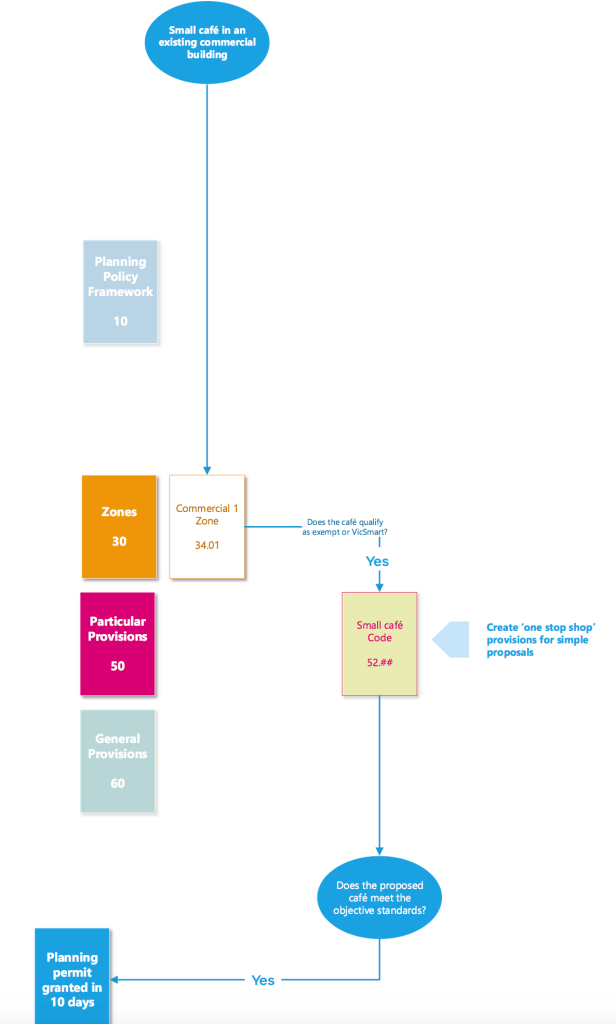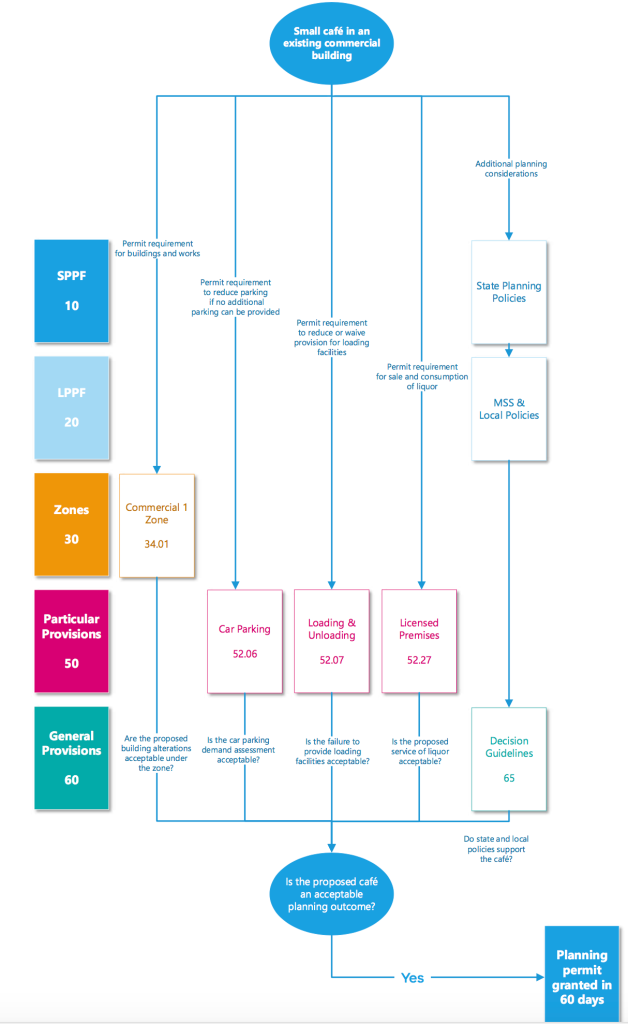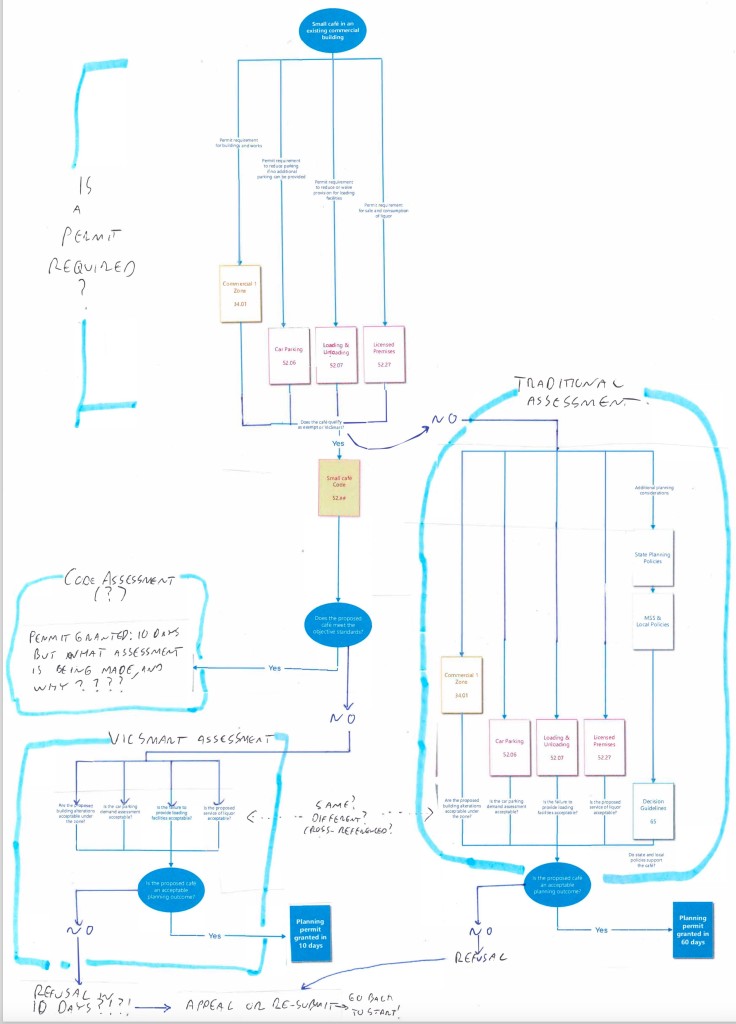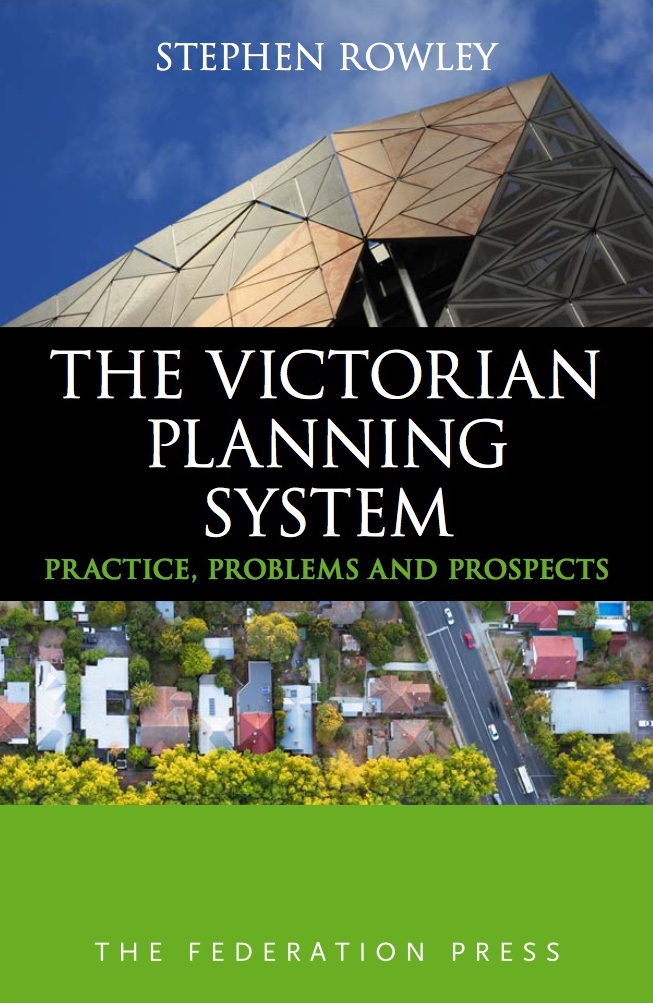The Smart Planning discussion paper has dropped. At some point I expect I’ll take a more detailed run through of what is a complex document that mixes various good ideas with a number of really bad ones. It’s an infuriating read, partly because it is so predictable: in its broad strokes, it’s pretty much exactly what could be envisaged from the Department’s material when I wrote about the program last year.
Rather than exhaustively work through the good and the bad of this new paper now, I wanted to focus on one really weird diagram and use it to unpick the hidden complexities of this document. That diagram is this one, one page 29 of the paper, showing a proposed new assessment to pathway for simpler matters.

It is presented in contrast to this one, outlining the existing process.

Wow, the existing system does look complex. And look at all that glorious white space in the new process – that does seem enticing.
[Edit 1 December – below is my attempt at a more honest reckoning of this system diagram. Excuse my crazy person hand-writing.]

Smart Planning system flow diagram
The benefit here is meant to flow from a few interlinked reforms:
- A reorganised set of particular provisions, with some increased attempt at thematic organisation (this is, I might add, a dead-set gold-plated good idea – at least in broad principle).
- VicSmart incorporated into particular provisions and overlay schedules.
- Increased use of code-assessment. This is, correctly, treated as distinct from VicSmart, which is not a code-assessment model (they are separate proposals at 3.1 and 3.2), although the discussion of the two does flow together somewhat throughout the paper. For example, on the diagram above, one flow line is used to represent code assessment against a “small cafe code” as well as VicSmart.
- Some general consolidation of controls, notably an integrated planning policy framework.
The issue with the diagram becomes clear when trying to work through a simple question, the first one a good statutory planner will ask: why does it need a permit?
If we look at the existing system diagram, we see our cafe (which is actually a “restaurant” for planning purposes, but never mind) needs a planning permit for buildings and works under the zone’s buildings and works trigger, a parking waiver under clause 52.06, a loading bay waiver under clause 52.07, and a licensed premises (i.e. liquor) permit under clause 52.27. This is a pretty common set of permit requirements, and it is not a coincidence that my ten simple fixes for the system included deeply winding back 52.06 and abolishing 52.27. (The appendix to the current document mentions both as needing review, but doesn’t suggest the strong reforms to either that are needed.) The diagram for the existing system notes the presence of these multiple triggers, which accounts for much of the complexity for the present-case system flowchart.
So back to my question: under the new system, why does the cafe need a permit? The diagram offers no clues: all those pesky triggers are simply gone.
Perhaps they have indeed removed those triggers. After all, they are all at least somewhat dispensable. But as I note the paper doesn’t advocate removal of even the most redundant of these requirements, and besides, if all the triggers were gone there would be no permit process and the diagram would be moot.
Perhaps the idea is just that all restaurants need a permit under the zone – after all, the flow arrow initially passes only through the zone. But that doesn’t seem very smart or targeted. It would expand the number of things that need a permit, which doesn’t seem in the spirit of the exercise.
So maybe the restaurant is assessed against much the same triggers, but they have been folded back into the zone? While that does sort of fit with the one-stop-shop rhetoric of the reforms, it is a pretty big change to the way planning is done that isn’t specifically canvassed elsewhere in the document. And it doesn’t simplify anything. We have big one-stop-shop zones now, in the Activity Centre Zones, and they have proved complex and unwieldy – this review even contemplates rolling them back (see page 47). And of course you’d end up replicating content such as parking controls across 30 or so zones.
Perhaps the permit triggers are in the “small cafe code” in the particular provisions? Despite the flowchart not really suggesting this, this feels a little more in the spirit of the reforms. But again, the detail doesn’t make sense. Do you split parking permit triggers across specific use codes? So things that have their own use code have the permit trigger in the code, and other uses in clause 52.06? And don’t we end up with a version of the zone problem, with really complex issue-by-issue replication of particular provisions? So for example, the small cafe, nightclub and tavern / bar particular provisions all have their own liquor triggers?
For what it’s worth, I don’t think any of these are what’s intended. The description of the new “one-stop-shop” particular provisions “set[ting] out permit exempt requirements,” with no mention of triggers (page 10 of the document), tells me the triggers will all still be where they are, but they will interact with a series of ad-hoc use-based clauses that then override the permit triggers and / or provide simplified decision guidelines. This is similar to the way other permit triggers need to be read against clause 62 exemptions at the moment, and also replicates the deeply problematic operation of VicSmart currently.
I raise the omission of permit triggers on the diagram because it highlights a couple of things. Firstly, the simplification in the new process diagram is mostly just from not drawing certain lines. Clause 52.06, 52.07, and 52.27 are all there. All the triggers mentioned at the top of the old diagram are still there. You can’t apply an exemption before you’ve established the trigger, so you still need to trace all those lines down to the small cafe code and then see whether a whole second clause overrides the first clause you looked at. What’s more, all the scary lines with questions on them at the bottom are presumably still there. Unless you’ve decided to remove the parking, loading and liquor issues from the system (in which case you should do it from the trigger end and get them out of the system properly) you are still asking all those questions.
If you actually draw the lines properly, what you actually get would actually look like a series of lines for each trigger coming in from the left. You’d measure the proposal against each tests and see whether you were in the system. Then you’d have lines coming in from the other side representing all the tests under your issues-based codes. So there’s a second level of tests then – does it meet the tests to qualify for the code, which overrides our first set of controls? If it does, it is assessed against one set of controls. If it doesn’t, the lines loop back and rejoin the old stream and all those lines are still there (notice there is no line for a cafe that doesn’t meet objective standards on the new process diagram). The lines with questions on them should still be there on this diagram, except twice (once for the original clause-based controls, and once for the side of the diagram showing a code-based assessment).
Omitting lines on system diagrams is not planning system reform.
Of course, we are offered “objective tests” on this diagram – surely that helps? This is the old code assessment furphy again, and I’ve addressed it at length elsewhere, notably pages 133-137 of my book and in this piece on VicSmart. The short version is that it is nonsensical to use a permit process to assess things for which you can identify objective tests. If you can identify objective tests, awesome – you have a clause that either does not trigger a permit, or exempts proposals from the need for a permit. Many VPP clauses operate this way. And if you can’t – well, that’s a normal permit-triggering clause with a merits assessment against decision guidelines and you haven’t reinvented any wheels. There’s just not a need under our system for a permit stream that is built around application of objective tests, and there never has been. This is why after years of development as a code assessment program VicSmart ended up being qualitative provisions. (This is not to say there is no role for processes to certify things against objective criteria, whether here or elsewhere. But in the Victorian framework at least these are better done through other processes – structured enquiry processes, or other kinds of approval such as building permits – rather than plugging them into the planning framework).
The other point highlighted by the omission of triggers is a key confusion built into these reforms. Forgetting to start with permit triggers is a common issue encountered when training and supervising new planners. It is so common for our controls to be framed so widely that young planners quickly fall into searching for exemptions, rather then first working out what the trigger is. If they can’t find an exemption, they assume it must need a permit. They are often right, but sometimes they’d be wrong. And starting from that end would obscure the question of why the permit was required.
The Smart Planning reforms show system reformers making a version of the same mistake. They are starting with the un-remarked assumption that everything needs a permit until it’s specifically exempted – the opposite of well-targeted system. And then they are concentrating on slimming the system down by coming up with exemptions and use-based clauses, and applying these on top of the existing system. That forces a complex interaction between triggering clauses and the overriding clauses which is inherently more complex than if the triggering clauses themselves were streamlined.
VicSmart had the same problem, and the incorporation of VicSmart into core scheme clauses (rather than being bolted on to the back of the system) suggests that this criticism has been heard at a superficial level. However the actual structural problem doesn’t seem to have been understood. Whatever the numbering strategy, the basic interaction that was so problematic – with core clauses being countermanded by other issues-based clauses – is preserved. Indeed, it’s becoming more complex, because now there would be a mix of VicSmart (proposal 3.1) and non-VicSmart (proposal 3.2) particular provisions that would override permit triggering clauses elsewhere.
It is telling that despite the work clearly being in a near-final phase – they are supposedly implementing in July 2018 – there are no draft clauses. The potential complexity of this model as the various issues-based codes are fed in is mind-boggling, with one set of particular provisions being over-ridden by one-stop shop-codes and VicSmart-enhanced overlays. It’s inherently messy and will lead to scheme bloat. How many of these issues-based codes and particular provisions will we have in time? What does any of this look like?
There is a failure here to properly appreciate what does work about the Victorian system, and which is confused by appealing sounding catch-phrases like “one-stop-shop.” There is a structural logic to aligning clauses with issues. If parking is an issue with a proposal, you assess it against that parking clause. If it’s in floodprone land, you assess it against the tests in a relevant overlay. If the use needs a permit, it’s assessed against the zone. There are various complex reasons why this model hasn’t worked out as well as it should have – and I wrote a whole book seeking to explain some of these issues – but that basic one-issue / one-trigger / one-clause logic is an underlying strength we should try to rediscover. This package of reforms is doubling (tripling?) down on the ad-hoccery that has obscured those underlying structural virtues.
What is odd is that the paper makes great play of the idea of “proportionality” in assessment (page 23) but then speaks disapprovingly of structuring overriding provisions “on a clause-by-clause basis rather than a land use basis” (page 24). But use-based clauses won’t lead to proportionality – stripping back to the original issues-based structure will. Under an issues-based structure, an application for buildings and works in a cafe is simpler than one that involves buildings and works and liquor; which in turn is simpler than one involving buildings and works and liquor and car parking. The considerations are added by each triggering clause. That’s proportional assessment.
By contrast, the proposed system essentially clashes use-based clauses against an issues-based regulatory foundation. To work, this requires endless new countermanding use-based clauses. The structural problems in the system remain, but are patched one use at a time. Every new use-based clause is a potential point of complexity and drafting problems; and every application is potentially assessed against either issue-based or use-based controls. It’s all very well to imagine a hypothetical cafe meeting a hypothetical cafe code, as the discussion paper does, but real proposals are vastly diverse and messy and involve different combinations of buildings, works, liquor, parking, signs and other triggers. Trying to come up with use-based codes that anticipate these and scale well is challenging. Won’t our cafe code be more complex than, say, assessing against only the loading bay controls if that’s the only trigger? Won’t the cafe code start to impose additional considerations on simple applications? How complex does the drafting have to get to anticipate all these problems?
It will be a clumsy and complex system.
It is therefore far better to approach the reduction of system burden from the permit trigger end. I have always advocated for starting with elimination of unnecessary triggers (clause 52.06 and 52.27 are classic candidates), and structural changes to avoid over-triggering (such as “flipped overlays” – see point 6 here). Exemptions have a place to help narrow wide triggers where they do exist (hence my suggestion of PDOs to allow targeted narrowing of other wide triggers such as zone triggers) but these are a second-best option. You can then also incorporate improvements to the way policy is framed – I am not a fan of the proposed integrated PPF mooted in this paper, but that is a discussion for another day – and top it off with meaningful changes to system monitoring and review. That’s the set of reforms I described in March.
Smart Planning’s wild proliferation of use-based overriding clauses would take us in the wrong direction.
